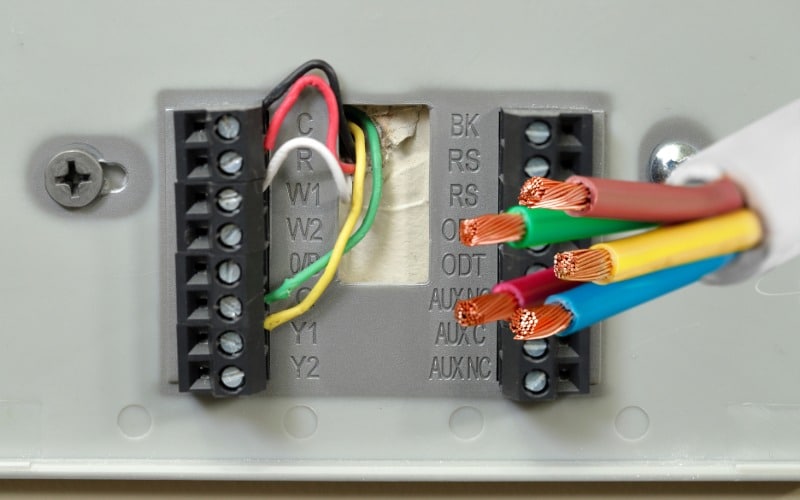Understanding thermostat wiring is a crucial skill for every homeowner. This blog post offers a clear and concise overview of thermostat wire colors and their meanings.
Whether you’re troubleshooting your thermostat or installing a new smart model, having knowledge of thermostat wire color codes will help you avoid DIY wiring mistakes. Remember that the wire colors mentioned here are common; your thermostat may have different color-coded wires. It’s always best to seek professional assistance for thermostat installation if you’re unsure.
Thermostat wires are low-voltage solid copper wires used for various purposes within the thermostat and the connected systems. Typically, thermostat wires are plenum-rated unless they don’t need to pass through air-circulation spaces in buildings.
Different Types of Thermostat Wiring
To understand how thermostat wire color codes work, it’s important to know that thermostats can have two or more wires, depending on the desired functionality.
Always refer to the manufacturer’s instructions before performing any wiring. Thermostat wiring configurations can vary.
Two Wires:
If you have 2 wires, chances are you have a digital thermostat that controls heating only (without air conditioning). The most common wire colors for this configuration are red and white.
Three Wires:
This configuration is commonly used for digital thermostats connecting to and controlling boilers. It includes a 24-volt hot wire, a 24-volt common wire, and a white wire.
Four Wires:
A popular setup for battery-powered thermostats or digital thermostats that regulate heat only. The standard configuration includes the following:
- A 24-volt hot wire (red).
- A 24-volt common wire (blue).
- A heated wire (white).
- A fan wire (green).
Five Wires:
This is the most typical thermostat wiring style, applicable to systems controlling heating and air conditioning. The wire colors are usually red for 24-volt hot, white for heat, yellow for cooling, green for the fan, and blue for common (although the common wire may have a different color).

Six, Seven, and Eight Wire Thermostats:
These configurations are utilized in more complex HVAC systems, such as two-stage heating or cooling systems, heat pumps with intricate setups, or control alarm systems.
Thermostat Wire Color Code
Please note that while the following thermostat wire colors are commonly used, there is no official standard for thermostat wire colors. Wiring methods and colors can vary. The colors mentioned here are based on my extensive experience in the HVAC field, manufacturer recommendations, and common sense for thermostat wiring color codes.
Blue: The blue wire is the common wire that connects to the power source and is essential for the thermostat’s operation. It usually connects to the heat pump and may also be black.
White: The white wire connects to the primary heating unit and terminates at the air handler or furnace. HVAC systems with multiple heating stages may have multiple white wires.
Red: The red wire connects to the R terminal and supplies 24V power to the unit.
Rc: Rc wires are used in dual transformer systems and connect to the cooling power supply.
Rh: Rh wires connect to the heating power supply.
Green: The green wire connects to the fan relay, controlling the furnace or air handler’s fan.
Yellow: The yellow wire connects to the air conditioner, running from the air handler to the compressor.
Orange: The orange wire is typically found in homes with air-source heat pumps and connects to the outdoor condenser. It may not be present for geothermal heat pump systems.
What happens if you wire the thermostat wrong?
Incorrect wiring can have serious consequences, including circuit breaker trips, thermostat or HVAC unit damage, and improper functioning.
Please note that thermostat wire color codes are standardized across only some brands. Each brand may have its own specific color coding system, and it’s essential to carefully review the instruction manual provided with your purchased thermostat.
For example, the wire color code used for Honeywell thermostats may differ from that of White Rogers or EcoBee thermostats. To ensure a successful installation or rewiring process, thoroughly read and follow the information in the accompanying instruction manual.
If you lack basic thermostat wire color code knowledge, it’s strongly advised to entrust thermostat installation to a professional. A professional HVAC technician will determine the ideal wiring configuration for your thermostat and provide expert guidance on its optimal placement. Trust the experts to handle your thermostat wiring needs for a seamless and efficient HVAC system.






